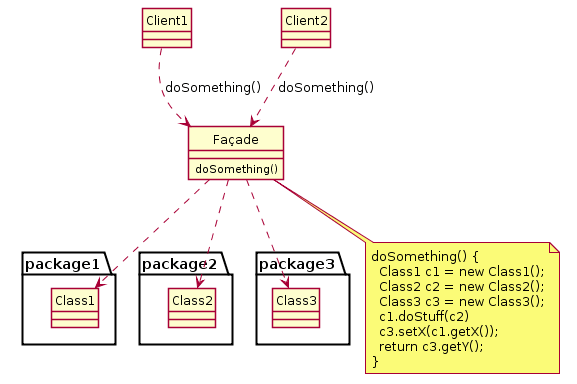PlantUML
PlantUML is an open-source tool allowing users to create UML diagrams from a plain text language. The language of PlantUML is an example of a Domain-specific language.[4] It uses Graphviz software to lay out its diagrams. It has been used to allow blind students to work with UML.[5][6] PlantUML also helps blind software engineers to design and read UML diagrams.
| Developer(s) | Arnaud Roques[1] |
|---|---|
| Initial release | 17 April 2009[2] |
| Stable release | 1.2020.13[3]
/ 13 June 2020 |
| Repository | |
| Written in | Java |
| Operating system | Linux, OS X, Windows |
| Type | UML Modeling |
| License | GNU General Public License |
| Website | plantuml |
Applications that use PlantUML
There are various extensions or add-ons that incorporate PlantUML.
- Atom has a community maintained plantuml syntax highlighter and viewer.
- Confluence (software) WIKI has a PlantUML plug-in for Confluence Server, which renders diagrams on-the-fly during a page reload. There is an additional PlantUML plug-in for Confluence Cloud.
- Doxygen integrates diagrams for which sources are provided after the \startuml command.
- Eclipse has a PlantUML plug-in.
- Google Docs has an add-on called PlantUML Gizmo that works with the PlantUML.com server.
- IntelliJ IDEA can create and display diagrams embedded into Markdown (built-in) or in standalone files (using a plugin).
- LaTeX using the Tikz package has limited support for PlantUML.
- LibreOffice has Libo_PlantUML extension to use PlantUML diagrams.
- MediaWiki has a PlantUML plug-in which renders diagrams in pages as svg or png.[7]
- Microsoft Word can use PlantUML diagrams via a Word Template Add-in. There is an additional Visual Studio Tools for Office add-in called PlantUML Gizmo that works in a similar fashion.
- NetBeans has a PlantUML plug-in.
- Org-mode has a PlantUML org-babel support.
- Rider (software) has a PlantUML plug-in.
- Visual Studio Code has a PlantUML plug-in for Microsoft IDE users.
Text format to communicate UML at source code level
PlantUML uses well-formed and human-readable code to render the diagrams.
There are other text formats for UML modelling but PlantUML supports many diagram types and does not need an explicit layouting, though it is possible to tweak the diagrams if necessary.
Example
The source code for the class diagram shown on the right is as follows:

skinparam style strictuml
class Façade {
doSomething()
}
Façade .> package1.Class1
Façade .> package2.Class2
Façade .> package3.Class3
Client1 .> Façade : doSomething()
Client2 .> Façade : doSomething()
note as N2
doSomething() {
Class1 c1 = newClass1();
Class2 c2 = newClass2();
Class3 c3 = newClass3();
c1.doStuff(c2)
c3.setX(c1.getX());
return c3.getY();
}
end note
Façade .. N2
References
- "PlantUML overview".
- "Plantuml".
- "list of evolutions and bug fixes".
- Campagne, Fabien (June 16, 2014). The MPS Language Workbench, Vol. 1. CreateSpace Independent Publishing Platform. ISBN 9781497378650.
- Luque, L.; Veriscimo, E.S.; Pereira, G.C.; Filgueiras, L.V.L. (2014). "Can We Work Together? On the Inclusion of Blind People in UML Model-Based Tasks". In P.M. Langdon; J. Lazar; A. Heylighen; et al. (eds.). Inclusive Designing Joining Usability, Accessibility, and Inclusion (Aufl. 2014 ed.). Cham: Springer International Publishing. ISBN 978-3-319-05095-9.
- Müller, Karin (2012). "How to Make Unified Modeling Language Diagrams Accessible for Blind Students". In Klaus Miesenberger (ed.). Computers Helping People With Special Needs 13th International Conference, ICCHP 2012, Linz, Austria, July 11-13, 2012, Proceedings, Part I. Berlin [u.a.]: Springer-Verlag New York Inc. pp. 186–190. ISBN 978-3-642-31521-3.
- "Extension:PlantUML - MediaWiki". www.mediawiki.org. Retrieved 2018-10-21.